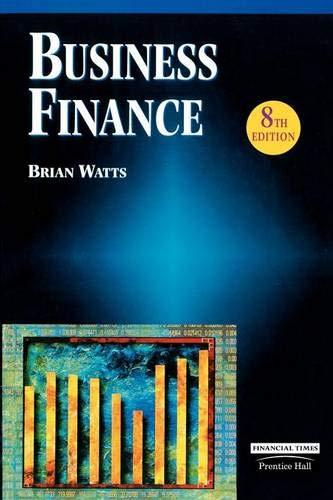Exhibit A (below) presents the income statement and balance sheet for Thread Co, a producer of high-quality fabrics and linens used to make expensive clothing which only the truly intelligent segments of society can appreciate. (The clothes are made in Denmark by Hans Christian Andersen and Associates.) The company is expected to increase revenues by 5 percent annually for the next six years (2022-2027) Using the template in Exhibit A, forecast the next six years of income statements for Thread Co. Assume that the next six years' forecast ratios are identical to the ratios for 2021. Forecast depreciation as a percentage of the previous year's PP&E. Forecast interest expense as a percentage of the previous year's debt. Next, forecast each balance sheet item as a function of revenues, except inventory and accounts payable, which should be forecasted as a function of cost of sales. Assume equity investments remain the same as the current year. Assume the firm maintains the same dividend payout ratio as the current year. S million Income statement Revenues Cost of sales Selling costs Depreciation Operating profit Interest expense Earnings before taxes Taxes Net income Dividends Balance sheet Assets Working cash Excess cash and marketable securities Accounts receivable Inventory Current assets roperty, plant and equipment 2020 1,450.0 (1,087.5) (217.5) (27.6) 117.4 (15.0) 102.4 (19.5) 82.9 9.0 2020 29.0 44.2 130.5 152.3 356.0 725.0 330.0 2021 1,595.0 (1,116.5) (239.3) (87.0) 152.3 (15.0) 137.3 (27.5) 109.8 17.0 2021 31.9 108.8 118.8 133.7 393.2 797.5 3200 2022 2022 2023 2023 2024 2024 2025 2025 2026 2026 2027 2027 Liabilities and equity 133.7 90.0 90.0 Accounts payable Short-term debt Accrued expenses Current liabilities 88.0 95.0 301.8 318.7 Long-term debt 210.0 210.0 Newly issued debt 0.0 0.0 Common stock 150.0 150.0 Retained earnings 739.2 832.0 Liabilities and equity 1,401.0 1,510.7 Liabilities and equity except newly issued debt b Calculate NOPLAT, invested capital, ROIC, and Free Cash Flows (FCF) for each year based on your forecast from part a (above). To keep things simple, calculate ROIC using the amount of invested capital held at the end of the previous period. (In other words, don't average the previous and current year's invested capital.) 2020 2021 2022 2023 2024 2025 2026 NOPLAT Operating current assets Operating current liabilities Owc PP&E Invested capital (note there is no goodwill) ROIC (using previous year's IC) Calculation of free cash flows 123.8 2027 NOPLAT Operating current assets Operating current liabilities OWC PP&E Invested capital (note there is no goodwill) ROIC (using previous year's IC) Calculation of free cash flows Free cash flows (FCFS) 2020 2021 2022 2023 2024 2025 2026 2027 Exhibit A (below) presents the income statement and balance sheet for Thread Co, a producer of high-quality fabrics and linens used to make expensive clothing which only the truly intelligent segments of society can appreciate. (The clothes are made in Denmark by Hans Christian Andersen and Associates.) The company is expected to increase revenues by 5 percent annually for the next six years (2022-2027) Using the template in Exhibit A, forecast the next six years of income statements for Thread Co. Assume that the next six years' forecast ratios are identical to the ratios for 2021. Forecast depreciation as a percentage of the previous year's PP&E. Forecast interest expense as a percentage of the previous year's debt. Next, forecast each balance sheet item as a function of revenues, except inventory and accounts payable, which should be forecasted as a function of cost of sales. Assume equity investments remain the same as the current year. Assume the firm maintains the same dividend payout ratio as the current year. S million Income statement Revenues Cost of sales Selling costs Depreciation Operating profit Interest expense Earnings before taxes Taxes Net income Dividends Balance sheet Assets Working cash Excess cash and marketable securities Accounts receivable Inventory Current assets roperty, plant and equipment 2020 1,450.0 (1,087.5) (217.5) (27.6) 117.4 (15.0) 102.4 (19.5) 82.9 9.0 2020 29.0 44.2 130.5 152.3 356.0 725.0 330.0 2021 1,595.0 (1,116.5) (239.3) (87.0) 152.3 (15.0) 137.3 (27.5) 109.8 17.0 2021 31.9 108.8 118.8 133.7 393.2 797.5 3200 2022 2022 2023 2023 2024 2024 2025 2025 2026 2026 2027 2027 Liabilities and equity 133.7 90.0 90.0 Accounts payable Short-term debt Accrued expenses Current liabilities 88.0 95.0 301.8 318.7 Long-term debt 210.0 210.0 Newly issued debt 0.0 0.0 Common stock 150.0 150.0 Retained earnings 739.2 832.0 Liabilities and equity 1,401.0 1,510.7 Liabilities and equity except newly issued debt b Calculate NOPLAT, invested capital, ROIC, and Free Cash Flows (FCF) for each year based on your forecast from part a (above). To keep things simple, calculate ROIC using the amount of invested capital held at the end of the previous period. (In other words, don't average the previous and current year's invested capital.) 2020 2021 2022 2023 2024 2025 2026 NOPLAT Operating current assets Operating current liabilities Owc PP&E Invested capital (note there is no goodwill) ROIC (using previous year's IC) Calculation of free cash flows 123.8 2027 NOPLAT Operating current assets Operating current liabilities OWC PP&E Invested capital (note there is no goodwill) ROIC (using previous year's IC) Calculation of free cash flows Free cash flows (FCFS) 2020 2021 2022 2023 2024 2025 2026 2027










